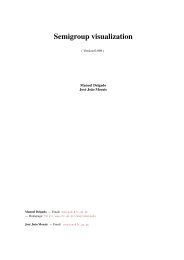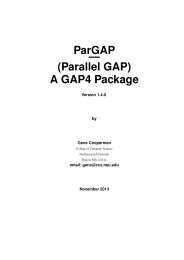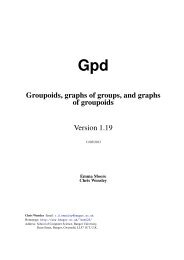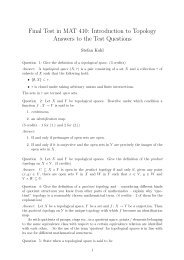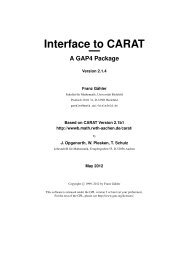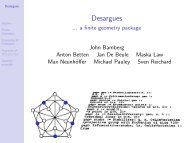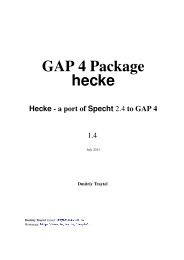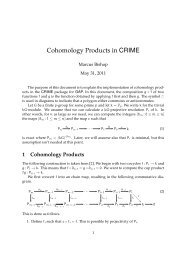guava - Gap
guava - Gap
guava - Gap
Create successful ePaper yourself
Turn your PDF publications into a flip-book with our unique Google optimized e-Paper software.
Chapter 1<br />
Introduction<br />
1.1 Introduction to the GUAVA package<br />
This is the manual of the GAP package GUAVA. GUAVA contains many functions that allow one to<br />
perform computations relevant to the theory of error-correcting codes. This version of GUAVA requires<br />
GAP 4.4.5 or later. GUAVA 3.12 was updated to work with GAP 4.5.3.<br />
The functions in GUAVA can be divided into three subcategories:<br />
• Construction of codes: GUAVA can construct unrestricted, linear and cyclic codes. Information<br />
about the code, such as operations applicable to the code, is stored in a record-like data structure<br />
called a GAP object.<br />
• Manipulations of codes: Manipulations transform one code into another, or construct a new<br />
code from two codes. The new code can profit from the data in the record of the old code(s), so<br />
in these cases calculation time often decreases.<br />
• Computations of information about codes: GUAVA can calculate important parameters of codes<br />
quickly. The results are stored in the codes’ object components.<br />
Except for the automorphism group and isomorphism testing functions, which make use of J.S.<br />
Leon’s programs (see [Leo91] and the documentation in the ’src/leon’ subdirectory of the ’<strong>guava</strong>’<br />
directory for some details), and MinimumWeight (4.8.5) function, GUAVA is written in the GAP language,<br />
and runs on any system supporting GAP4.4 and above. Several algorithms that need the speed<br />
were integrated in the GAP kernel.<br />
Good general references for error-correcting codes and the technical terms in this manual are<br />
MacWilliams and Sloane [MS83] and also Huffman and Pless [HP03].<br />
1.2 Installing GUAVA<br />
The most recent version of GAP (4.5) comes complete with all of the packages – including GUAVA.<br />
Thus the following instructions are not usually applicable but may be needed in certain circumstances.<br />
To install GUAVA unpack the archive file in a directory in the ‘pkg’ hierarchy of your version of<br />
GAP 4.<br />
After unpacking GUAVA the GAP-only part of GUAVA is installed. The parts of GUAVA depending<br />
on J. Leon’s backtrack programs package (for computing automorphism groups) are only available in<br />
12



